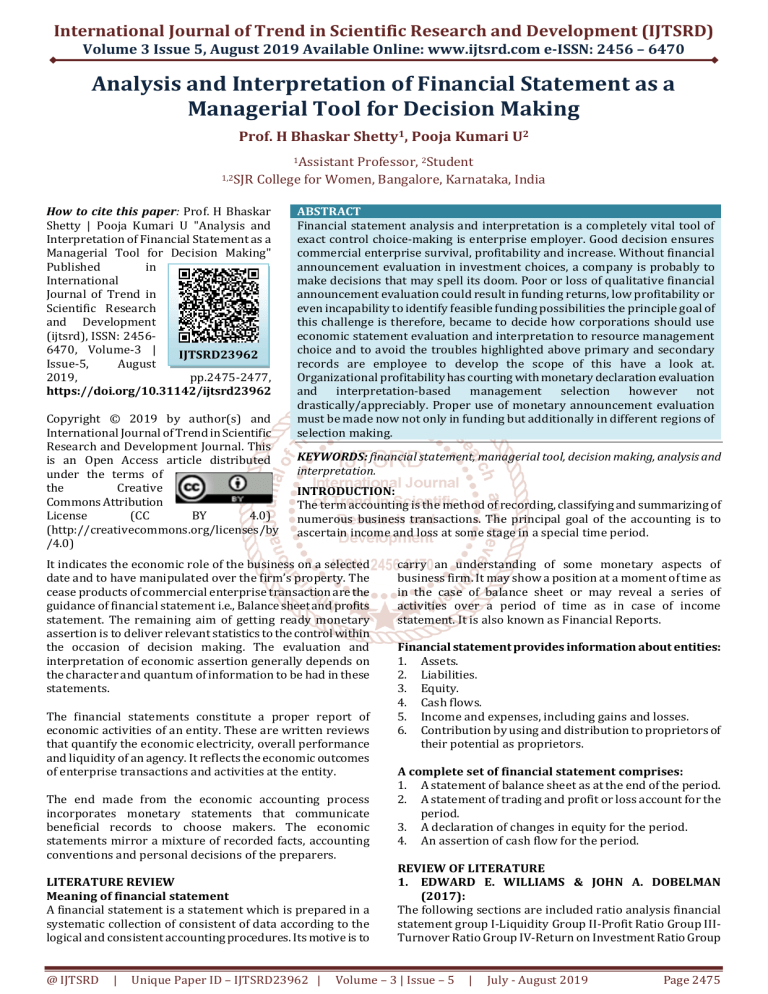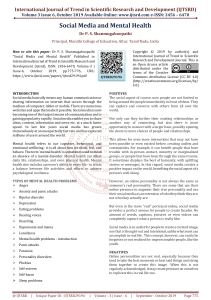
International Journal of Trend in Scientific Research and Development (IJTSRD)
Volume 3 Issue 5, August 2019 Available Online: www.ijtsrd.com e-ISSN: 2456 – 6470
Analysis and Interpretation of Financial Statement as a
Managerial Tool for Decision Making
Prof. H Bhaskar Shetty1, Pooja Kumari U2
1Assistant
Professor, 2Student
1,2SJR College for Women, Bangalore, Karnataka, India
How to cite this paper: Prof. H Bhaskar
Shetty | Pooja Kumari U "Analysis and
Interpretation of Financial Statement as a
Managerial Tool for Decision Making"
Published
in
International
Journal of Trend in
Scientific Research
and Development
(ijtsrd), ISSN: 24566470, Volume-3 |
IJTSRD23962
Issue-5,
August
2019,
pp.2475-2477,
https://doi.org/10.31142/ijtsrd23962
Copyright © 2019 by author(s) and
International Journal of Trend in Scientific
Research and Development Journal. This
is an Open Access article distributed
under the terms of
the
Creative
Commons Attribution
License
(CC
BY
4.0)
(http://creativecommons.org/licenses/by
/4.0)
ABSTRACT
Financial statement analysis and interpretation is a completely vital tool of
exact control choice-making is enterprise employer. Good decision ensures
commercial enterprise survival, profitability and increase. Without financial
announcement evaluation in investment choices, a company is probably to
make decisions that may spell its doom. Poor or loss of qualitative financial
announcement evaluation could result in funding returns, low profitability or
even incapability to identify feasible funding possibilities the principle goal of
this challenge is therefore, became to decide how corporations should use
economic statement evaluation and interpretation to resource management
choice and to avoid the troubles highlighted above primary and secondary
records are employee to develop the scope of this have a look at.
Organizational profitability has courting with monetary declaration evaluation
and interpretation-based management selection however not
drastically/appreciably. Proper use of monetary announcement evaluation
must be made now not only in funding but additionally in different regions of
selection making.
KEYWORDS: financial statement, managerial tool, decision making, analysis and
interpretation.
INTRODUCTION:
The term accounting is the method of recording, classifying and summarizing of
numerous business transactions. The principal goal of the accounting is to
ascertain income and loss at some stage in a special time period.
It indicates the economic role of the business on a selected
date and to have manipulated over the firm’s property. The
cease products of commercial enterprise transaction are the
guidance of financial statement i.e., Balance sheet and profits
statement. The remaining aim of getting ready monetary
assertion is to deliver relevant statistics to the control within
the occasion of decision making. The evaluation and
interpretation of economic assertion generally depends on
the character and quantum of information to be had in these
statements.
The financial statements constitute a proper report of
economic activities of an entity. These are written reviews
that quantify the economic electricity, overall performance
and liquidity of an agency. It reflects the economic outcomes
of enterprise transactions and activities at the entity.
The end made from the economic accounting process
incorporates monetary statements that communicate
beneficial records to choose makers. The economic
statements mirror a mixture of recorded facts, accounting
conventions and personal decisions of the preparers.
LITERATURE REVIEW
Meaning of financial statement
A financial statement is a statement which is prepared in a
systematic collection of consistent of data according to the
logical and consistent accounting procedures. Its motive is to
@ IJTSRD
|
Unique Paper ID – IJTSRD23962 |
carry an understanding of some monetary aspects of
business firm. It may show a position at a moment of time as
in the case of balance sheet or may reveal a series of
activities over a period of time as in case of income
statement. It is also known as Financial Reports.
Financial statement provides information about entities:
1. Assets.
2. Liabilities.
3. Equity.
4. Cash flows.
5. Income and expenses, including gains and losses.
6. Contribution by using and distribution to proprietors of
their potential as proprietors.
A complete set of financial statement comprises:
1. A statement of balance sheet as at the end of the period.
2. A statement of trading and profit or loss account for the
period.
3. A declaration of changes in equity for the period.
4. An assertion of cash flow for the period.
REVIEW OF LITERATURE
1. EDWARD E. WILLIAMS & JOHN A. DOBELMAN
(2017):
The following sections are included ratio analysis financial
statement group I-Liquidity Group II-Profit Ratio Group IIITurnover Ratio Group IV-Return on Investment Ratio Group
Volume – 3 | Issue – 5
|
July - August 2019
Page 2475
International Journal of Trend in Scientific Research and Development (IJTSRD) @ www.ijtsrd.com eISSN: 2456-6470
V-Leverage and Capital Structure Ratio Group VI-AssetsRelation Ratio Group VII-Common Stock Security Ratio
Group VIII-Yield and Price Ratio Common Size Analysis
adjustments to financial and accounting data financial
analysis for mergers.
2. MATHIEU LUYPAERT, TOM VAN CANEGHEM, STEVE
VAN UYTBERGEN (2016):
This article verifies financial statement filing lags among a
sample of Belgian small firms. Our results indicate that
around one-third of small firm financial statement are filed
late (after the legal deadline), but that monitory sanctions
could be an effective tool to encourage compliance with legal
deadline. Whereas the deadline and late filing sanctions are
filing incentives, various factors, such as firm size and
presence of an external financial statement audit, also affect
financial statement filing lags. Evidence indicated that
extremely late filings were associated with lower financial
statement quality.
3. RAVICHANDRAN M & SUBRAMANIUM M VENKATA
(2016):
The main idea behind this study is to assessment of viability,
stability and profitability of force motors limited. Operating
position of the company can be measured by using various
financial tools such as profitability ratio, solvency ratio,
comparative statement & graphs etc. This study finds that
company has got enough funds to meet its debts & liabilities.
Company can further improve financial performance by
reducing the administrative, selling & operating expenses.
4. DANIEL A. MOSES JOSHUNAR (2013):
The study has been conducted to identify the financial
strength and weakness of the Tata Motors limited using past
five-year financial statements. Trend analysis and ratio
analysis used to comment of financial status of company.
Financial performance of company is satisfactory and also
suggested to increase the loan levels of company for the
better performance.
5. JAIN, D.C (1967):
Has analyzed the financial statements of cement companies
in India. The study revealed by and large that their financial
performance was satisfactory, on the basis of ratio analysis
made.
SCOPE OF THE STUDY:
The study is conducted to cover the analysis of financial
statement of particular firm of about 10 years. The study is
conducted to cover the use of financial statement which
includes; balance sheet, income statement, statement of cash
flow and statement of retained earnings; analysis civil
interpretation management choice. The study is conducted
to cover related various other business records including
order copy etc.
OBJECTIVES OF THE STUDY
This research is aimed at examining how efficiently the
management will apply financial statement in making
business decision.
The main objectives of the study are:
1. To find out how the use of financial statement analysis
assists organizations in identifying investment
opportunities.
@ IJTSRD
|
Unique Paper ID – IJTSRD23962 |
2.
To find out how growing investment returns may be
done the use of financial statement analysis.
3.
To find out how profitability is affected.
4.
To identify alternative methods of minimizing
investment risk.
RESEARCH METHODOLOGY
SAMPLING: Sampling and data analysis play a vital role
in the research project with prescribed plan and suitable
sampling size.
Sampling is a process used in statistical analysis in
which pre-set numbers of observations are taken from a
larger population.
SAMPLING SIZE: The total sample size for gathering
required information from company and employees
through random sampling method.
Sampling size refers to the number of elements to be
chosen from the population to conduct the study. The
sample size for this study is 75.
NEED FOR THE STUDY
The data collected from the company has been analysed
according to the objectives of the study and to suggest
suitable improvements that are needed for the company. The
data collected through questionnaire is analysed and
interpreted with the help of table and graphs to come out
with effective findings, conclusion and suggestions.
The information from the questionnaire is classified and
analyzed.
The calculation of the result is in the percentage form.
Result is highlighted through graphs and charts.
VARIABLES
Independent variable:
DECISION MAKING:
It is the study of identifying and choosing alternative based
on the values and preference to the decision making. It is a
process which includes a combination of many stages that
lead to effective outcome. This process can be very simple in
some areas but in another especially in business, it may be
more complex.
Dependent variable:
FINANCIAL STATEMENT:
A financial statement is a statement which is prepared in a
systematic collection of consistent of data according to the
logical and consistent accounting procedures. Its motive is to
carry an understanding of some monetary aspects of
business firm. It may show a position at a moment of time as
in the case of balance sheet or may reveal a series of
activities over a period of time as in case of income
statement. It is also known as Financial Reports.
FINDINGS
This research work has identified how companies use
financial statement analysis and interpretation in
making effective management decisions.
Overall organizational profitability and achievement of
organizational objectives were discussed.
Volume – 3 | Issue – 5
|
July - August 2019
Page 2476
International Journal of Trend in Scientific Research and Development (IJTSRD) @ www.ijtsrd.com eISSN: 2456-6470
Again, the difference between the returns of a financial
statement analysis and interpretation based on
management decision were also discussed.
The adequacy of financial information needs to be
emphasized on, as it will provide enough and necessary
details for investment and management decisions.
A combination of different ratios should be used to
analyze a company’s financial and/or operating
performance.
Finally, the management of the chosen company needs
to make right use of financial announcement analysis in
different decision areas of control now not most
effective in investment selection.
CONCLUSION
The main objective of this study was to determine how firms
could use financial statement analysis to aid investment and
management decisions in the selected company.
The study revealed that financial statement performs a
crucial role on management decision making and
organization performance which has been shown to be a
major force in decision making. This is achieved by
implementing the best fundamental concepts and modern
@ IJTSRD
|
Unique Paper ID – IJTSRD23962 |
techniques, instruments of financial statement suitable for
the company.
The study also showed the financial statement plays a vital
role in taking the effective, accurate and significant decisions
in the company. The study got that the financial statement as
a managerial tool for decision making is using by the
company is significant.
REFERENCE
[1] CA. K. Hariharan (2017), “Cost and management
accounting and financial management”, K.G.
Maheshwari book corporation, 10th edition.
[2] M. N. Arora, Priyanka Katya (2017), “Management
Accounting”, Himalaya publishing house, 8th edition.
[3] Meigs, W. B. and Meigs, R. F. (2003), “Financial
Accounting”, USA: McGraw Hill publications.
[4] Pandey, I. M. (2005), “Financial Management”, London:
Vitkus publishing house PVT Limited.
[5] Dr. V. R. Palanivelu (2011), “Financial Management”, S.
Chand, Revised edition.
Volume – 3 | Issue – 5
|
July - August 2019
Page 2477






